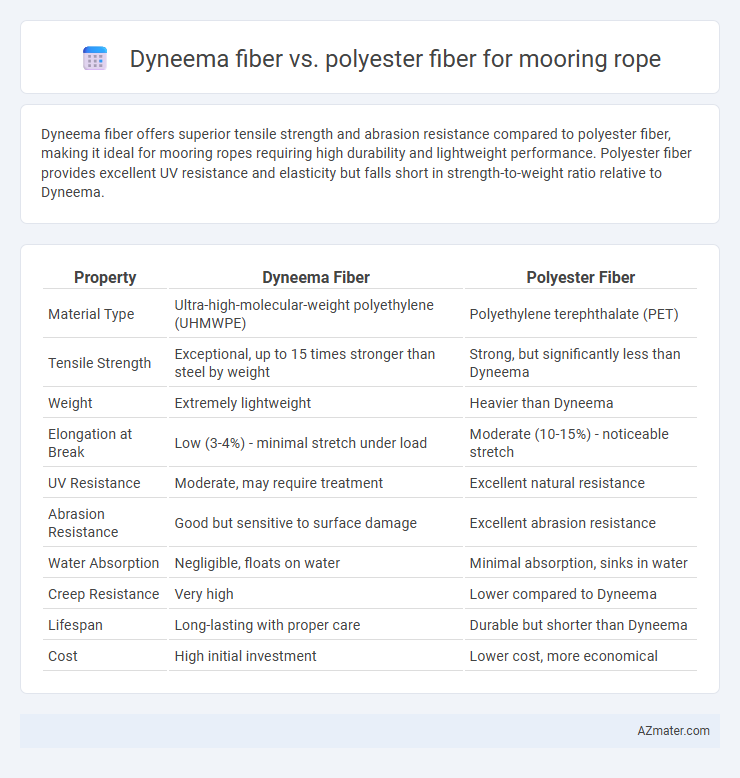Dyneema fiber offers superior tensile strength and abrasion resistance compared to polyester fiber, making it ideal for mooring ropes requiring high durability and lightweight performance. Polyester fiber provides excellent UV resistance and elasticity but falls short in strength-to-weight ratio relative to Dyneema.
Table of Comparison
| Property | Dyneema Fiber | Polyester Fiber |
|---|---|---|
| Material Type | Ultra-high-molecular-weight polyethylene (UHMWPE) | Polyethylene terephthalate (PET) |
| Tensile Strength | Exceptional, up to 15 times stronger than steel by weight | Strong, but significantly less than Dyneema |
| Weight | Extremely lightweight | Heavier than Dyneema |
| Elongation at Break | Low (3-4%) - minimal stretch under load | Moderate (10-15%) - noticeable stretch |
| UV Resistance | Moderate, may require treatment | Excellent natural resistance |
| Abrasion Resistance | Good but sensitive to surface damage | Excellent abrasion resistance |
| Water Absorption | Negligible, floats on water | Minimal absorption, sinks in water |
| Creep Resistance | Very high | Lower compared to Dyneema |
| Lifespan | Long-lasting with proper care | Durable but shorter than Dyneema |
| Cost | High initial investment | Lower cost, more economical |
Introduction to Mooring Ropes: Dyneema vs Polyester
Dyneema fiber offers exceptional strength-to-weight ratio and low stretch, making it ideal for mooring ropes requiring high load capacity and minimal elongation under tension. Polyester fiber provides good UV resistance, abrasion resistance, and moderate stretch, offering durability and cost-effectiveness for general mooring applications. Comparing mooring performance, Dyneema outperforms in dynamic load scenarios, while polyester remains a reliable choice for traditional, less demanding mooring environments.
Overview of Dyneema Fiber Properties
Dyneema fiber exhibits exceptional tensile strength, being up to 15 times stronger than steel by weight, which makes it ideal for mooring ropes subjected to extreme loads and harsh marine environments. Its superior abrasion resistance, low stretch (less than 3%), and excellent UV and chemical resistance ensure longevity and reliability in demanding mooring applications. Dyneema's lightweight nature reduces vessel weight and improves handling compared to traditional polyester fiber ropes, which typically have higher elongation and lower strength.
Overview of Polyester Fiber Properties
Polyester fiber used in mooring ropes offers high tensile strength, excellent abrasion resistance, and good UV stability, making it durable in harsh marine environments. Its low stretch characteristics provide reliable load-bearing capacity and minimal elongation under tension, ensuring safe and secure mooring operations. Polyester's resistance to water absorption and chemical exposure further enhances its longevity and performance in offshore applications.
Breaking Strength Comparison: Dyneema vs Polyester
Dyneema fiber offers significantly higher breaking strength compared to polyester fiber, making it ideal for mooring ropes requiring superior load-bearing capacity. Dyneema's tensile strength can be up to 15 times greater than steel on a weight-to-weight basis, whereas polyester provides moderate strength with better elasticity and abrasion resistance. Choosing Dyneema for mooring ropes enhances safety and performance in demanding maritime environments by ensuring exceptional durability and minimal stretch under heavy loads.
Weight and Handling Differences
Dyneema fiber exhibits a significantly lower weight compared to polyester fiber, making mooring ropes lighter and easier to handle during operations. Its high strength-to-weight ratio improves crew efficiency by reducing fatigue and enhancing maneuverability in demanding marine environments. Despite being lighter, Dyneema maintains exceptional durability and abrasion resistance, outperforming polyester in both handling characteristics and operational longevity.
Durability and Abrasion Resistance
Dyneema fiber offers superior durability and abrasion resistance compared to polyester fiber, making it an ideal choice for mooring ropes exposed to harsh marine environments. Its ultra-high-molecular-weight polyethylene structure provides exceptional strength-to-weight ratio and excellent resistance to UV damage, chemicals, and water absorption. Polyester fiber, while cost-effective, tends to degrade faster under constant friction and exposure, requiring more frequent replacement in demanding mooring applications.
Stretch and Elongation Characteristics
Dyneema fiber offers extremely low stretch and minimal elongation, typically less than 1%, making it ideal for mooring ropes requiring high strength and stability under load. Polyester fiber exhibits higher stretch and elongation rates, generally around 10-15%, which can absorb shock loads but may result in less precise rope positioning. The superior dimensional stability of Dyneema fiber ensures consistent tension and reduced risk of slack, enhancing mooring performance compared to polyester.
Chemical and UV Resistance
Dyneema fiber exhibits exceptional chemical resistance, maintaining strength and integrity when exposed to oils, solvents, and harsh marine chemicals, making it ideal for mooring ropes in corrosive environments. Polyester fiber offers moderate resistance to chemicals but degrades faster under prolonged exposure to harsh substances compared to Dyneema. Both fibers provide good UV resistance; however, Dyneema's molecular structure allows superior UV stability, extending the service life of mooring ropes in intense sunlight conditions.
Cost Analysis: Dyneema vs Polyester Ropes
Dyneema fiber mooring ropes exhibit significantly higher initial costs compared to polyester ropes, reflecting their superior tensile strength, lower weight, and enhanced durability. Polyester ropes offer a more budget-friendly option with moderate strength and wear resistance, making them suitable for less demanding applications where cost efficiency is prioritized. Long-term cost analysis favors Dyneema due to reduced maintenance, longer service life, and improved safety margins, often justifying the upfront investment in critical mooring operations.
Best Applications and Recommendations
Dyneema fiber offers exceptional strength-to-weight ratio, high abrasion resistance, and low stretch, making it ideal for heavy-duty mooring ropes in offshore and marine environments where durability and minimal elongation are critical. Polyester fiber provides good UV resistance, excellent weather durability, and moderate stretch, best suited for general mooring applications requiring affordability and flexibility in moderate-load conditions. For high-performance mooring, Dyneema is recommended, whereas polyester is preferred for cost-effective solutions with adequate strength and environmental resilience.

Infographic: Dyneema fiber vs Polyester fiber for Mooring rope
 azmater.com
azmater.com